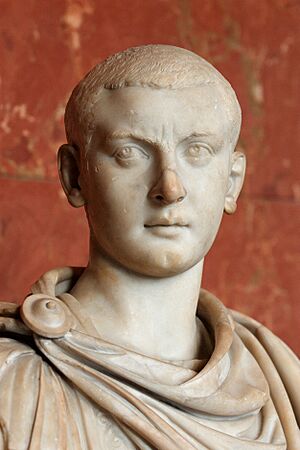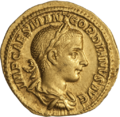Gordian III facts for kids
Quick facts for kids Gordian III |
|||||||||
|---|---|---|---|---|---|---|---|---|---|

Bust, 242–244
|
|||||||||
| Roman emperor | |||||||||
| Augustus | c. August 238 – February 244 | ||||||||
| Predecessor | Pupienus and Balbinus | ||||||||
| Successor | Philip the Arab | ||||||||
| Caesar | c. May – August 238 | ||||||||
| Born | 20 January 225 Rome, Italy |
||||||||
| Died | c. February 244 (aged 19) Zaitha |
||||||||
| Spouse | Tranquillina | ||||||||
|
|||||||||
| Dynasty | Gordian | ||||||||
| Father | Junius Balbus | ||||||||
| Mother | Antonia Gordiana | ||||||||
Gordian III (born Marcus Antonius Gordianus) was a Roman emperor. He ruled from 238 to 244 AD. He was born on January 20, 225. When he became emperor, he was only 13 years old. This made him the youngest sole ruler of the entire Roman Empire.
Gordian III was the son of Antonia Gordiana and Junius Balbus. His mother, Antonia Gordiana, was the daughter of Emperor Gordian I. She was also the younger sister of Emperor Gordian II. Not much is known about Gordian III's early life. He took on the name of his great-grandfather in 238.
Contents
How Gordian III Became Emperor

In 235, Emperor Alexander Severus was killed. After his death, Maximinus Thrax became the new emperor. But many people in Rome and the Roman Senate did not like Maximinus.
In 238, a rebellion started in the Africa Province. Gordian III's grandfather, Gordian I, and his uncle, Gordian II, were declared co-emperors. However, this revolt ended quickly. A governor loyal to Maximinus Thrax stopped it within a month.
The Senate still opposed Maximinus. So, they chose two new emperors: Pupienus and Balbinus. These men were not very popular. To gain more support, the Senate decided to give young Marcus Antonius Gordianus a special title. They made him a Caesar, which meant he was next in line to be emperor.
Maximinus Thrax quickly moved his army to attack the new emperors. But his army faced problems marching through the Alps in winter. When they reached the city of Aquileia, they ran out of supplies. Maximinus tried to attack the city. After four weeks, his soldiers were tired and angry. They rebelled and killed Maximinus.
Even with Maximinus gone, Pupienus and Balbinus faced many problems. There were riots in Rome and soldiers were unhappy. A huge fire also burned parts of the city in June 238. The next month, the Praetorian Guard (the emperor's personal bodyguards) killed Pupienus and Balbinus. After this, Gordian III was declared the sole emperor.
Gordian III's Time as Emperor
Because Gordian was so young, powerful families in Rome helped him rule. These families controlled the government through the Senate. In 240, a man named Sabinianus started a revolt in Africa. But he was quickly defeated.
In 241, Gordian married Furia Sabinia Tranquillina. She was the daughter of Timesitheus. Timesitheus was the new leader of the Praetorian Guard. As the emperor's father-in-law and head of the guard, Timesitheus became the real power behind the throne.
During Gordian's rule, there were also severe earthquakes. Some cities were completely destroyed. To understand these events, Gordian consulted ancient books called the Sibylline books.
By the 3rd century, the Roman borders were getting weaker. Germanic tribes attacked from across the Rhine and Danube rivers. The Sassanid Empire also attacked from the East, across the Euphrates river. When the Sassanids, led by Shapur I, invaded Mesopotamia, Emperor Gordian took action. He opened the doors of the Temple of Janus. This was a very rare event, done only when Rome was at war. He sent a large army to the East.
The Roman army pushed the Sassanids back across the Euphrates. They defeated them in the Battle of Resaena in 243. This military campaign was a big success. Gordian, who had joined the army, planned to invade the enemy's land. However, his father-in-law, Timesitheus, died under unclear circumstances. Without Timesitheus, the campaign and the emperor's safety were at risk.
Despite this, Gordian celebrated his success with a triumph in Rome. He proudly told the Senate about his achievements.
Gaius Julius Priscus and his brother, Philip the Arab, became the new Praetorian Prefects. Gordian then started a second military campaign. Around February 244, the Sassanids fought back strongly. They tried to stop the Roman advance towards their capital, Ctesiphon.
The End of Gordian III's Reign
The exact way Gordian III died is not fully clear. Roman records say that soldiers declared Philip the Arab emperor. They also claim Philip made a "shameful" peace with Shapur. These records state Gordian died as the Roman army left for the west. Another historian, Zonaras, wrote that Gordian died after falling from his horse during a battle.
An inscription from Shapur, the Sassanid king, tells a different story. It claims a battle happened near modern Fallujah in Iraq. This battle, called the Battle of Misiche, was a major Roman defeat. According to Shapur, Gordian III died in this battle. After that, Philip supposedly bought peace for a large sum of money.
Some historians believe Gordian died at a place called Zaitha. They think his own frustrated army might have killed him there. Philip's exact role in his death is still debated. Many experts think the Sassanid version of events is more likely. The Roman accounts don't explain why a victorious Roman army would make a bad peace deal.
What happened to Gordian's body is also a mystery. Some historians say Philip brought his body back to Rome. They believe Philip arranged for Gordian to be honored as a god. Others say Philip buried Gordian at Zaitha after the failed campaign against the Sassanids.
|
||||||||||||||||||||||||||||||||||||||||||||||||||||||||||||||||||||||||||||||||||||||||||||||||||||||||||||||||||||||||||||||||||||||||||||||||||||||||||||||||||||||||||||||||||||||||||||||||||||||||||||||||||||||||||||||||||
Images for kids
-
Aureus of Gordian III. Inscription: IMP. CAES. M. ANT. GORDIANVS AVG.
See also
 In Spanish: Gordiano III para niños
In Spanish: Gordiano III para niños





